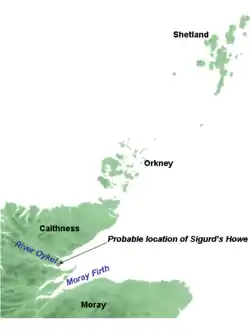Máel Brigte of Moray
Máel Brigte, also known as Máel Brigte the Bucktoothed or Máel Brigte Tusk[1] was a 9th-century Pictish nobleman, most probably a mormaer of Moray. He was responsible – in a bizarre posthumous incident – for the death of Earl Sigurd the Mighty of Orkney.

Death
Battle with Sigurd the Mighty
Little is known of Máel Brigte's life, but the story of his death is recorded in the Orkneyinga Saga. According to this text, Máel Brigte was challenged by Sigurd to a 40-man-a-side battle to "settle their differences". Treacherously, Sigurd brought 80 men to the fight, and Máel Brigte knew he had been betrayed when he saw that each of Sigurd's horses had two men's legs on its flanks. Máel Brigte exhorted his men to "kill at least one man before we die ourselves" and although a fierce fight ensued, Máel Brigte was defeated and killed.
Legacy
The site of the battle is unknown. However the saga states that Earl Sigurd built a stronghold in the south of Moray, then a much larger province than today[3] and that he was buried in a mound on the banks of the River Oykel.[2][4] Máel Brigte's power centre was probably in or near modern Inverness. In the 13th century a farm near Dornoch, now called Cyderhall is recorded as "Syvardhoch", meaning "Sigurd's mound".[1] It is therefore possible that the battle was staged in Easter Ross somewhere between these two places.
Nov2007.jpg.webp)
The Orkneyinga Saga records few specific dates and was not written down until circa 1200, some three centuries after the events it recorded about Máel Brigte and Sigurd took place. However it is thought that Sigurd Eysteinsson (aka "the Mighty"), ruled from about 875–92[5] so Máel Brigte's death may have taken place in the last quarter of the 9th century.[6]
There is no other record of Máel Brigte's life. Although another of this name is described in the mid 11th century as being the father of the Mormaer Máel Coluim of Moray.[7]
Notes
- Thomson (2008) p. 28.
- Pálsson and Edwards (1981) "A poisoned tooth". pp. 27-28.
- Prior to 1130 the name "Moray" described a polity, far larger than the later county or district of the same name, (based at Elgin) which at its largest extended from Drumochter in the south to the Scandinavian held lands of Caithness and Sutherland in the north. Oxford Companion to Scottish History. pp. 428–430.
- Thomson (2008) translates Ekkjalsbakki as "Dornoch Firth".
- Ashley, pp. 440–441.
- Some scholars believe that the Orkneyinga Saga reports of Harald I of Norway's expeditions are apocryphal and based on the later voyages of Magnus Barelegs. This would call into question the related tales of the early jarls of Orkney such as Sigurd Eysteinsson. See Thomson (2008) p. 24-27.
- Thomson (2008) p. 77.
References
- Ashley, Mike (1998). The Mammoth Book of British Kings and Queens. London. Robinson. ISBN 1-84119-096-9
- Oxford Companion to Scottish History. Edited by Michael Lynch. Oxford University Press. ISBN 978-0-19-923482-0.
- Pálsson, Hermann and Edwards, Paul Geoffrey (1981). Orkneyinga Saga: The History of the Earls of Orkney. Penguin Classics. ISBN 0-14-044383-5
- Thomson, William P. L. (2008) The New History of Orkney. Edinburgh. Birlinn. ISBN 978-1-84158-696-0
External links
- Orkneyinga saga at Sacred texts
- Orkneyinga saga at Northvegr
- grid reference NH758884 - likely location of Sigurd's Howe